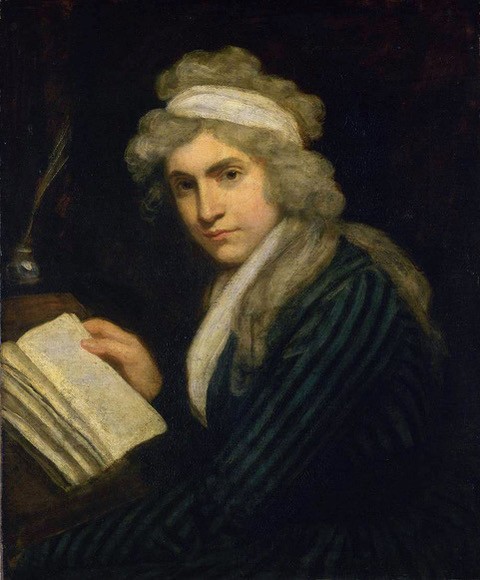“Mary Wollstonecraft in 1790 – 1791” by John Opie
“At a Glance . . .”
As mentioned in the meeting summary for October 2, this autumn we have returned to themes that were under discussion at our last in-person meeting on March 2020, just prior to Covid isolation.
We discussed the important British writers Mary Wollstonecraft and her daughter Mary Godwin Shelley, poets William Blake and Percy Shelley, the Platonist Thomas Taylor, poet and literary critic Kathleen Raine, C.S. Lewis, and Percy Shelley’s “Hymn to Intellectual Beauty.”
We advanced a bit with our Question: “What is the Significance of the Literary Arts and Humanities and How Does this Section Contribute Uniquely to a Spiritual Science?” To assist us with this discussion, we looked at the essay that Christiane Haid delivered at a Section conference in Montreal, Canada in 2017: “What is the Significance and Work of the Section for the Literary Arts and Humanities?” and the 2006 essay by Marguerite Miller “The Literary Arts and Humanities Section in North America.”
We scheduled our next Poetry Night for December 18.
We took a few more steps toward the production of a movie or play or reader’s theater that will make use of puppet figures that the Fairy Tale Group is planning to create. This artistic initiative that began at Michaelmas will occur as a separate activity from the Section meetings. Contact Marion for information.
We referenced Rudolf Steiner’s 1917 lecture cycle “The Fall of the Spirits of Darkness” in respect to the biographies of Wollstonecraft and the two Shelleys.
We discussed the German term “Geisteswissenschaft” and the problems of translation, and we made use of the last book by C.S Lewis, “The Discarded Image,” in attempt to understand the spiritual-scientific background of the revolutionary literary and historical events that occurred in the late eighteenth century and early to mid nineteenth century.

“Age of Steel and Steam; Locomotive Detail” photo by Bruce Donehower
“Tell me more . . .”
“Spirit of BEAUTY, that dost consecrate
With thine own hues all thou dost shine upon
Of human thought or form, where art thou gone?”— Percy Shelley, from “Hymn to Intellectual Beauty”
“The Fall of the Spirits of Darkness”
The spirit of linear, mathematical-materialist thinking that Rudolf Steiner repeatedly discussed as a determining characteristic of the nineteenth century and early twentieth century came into our discussion under several points of criticism last night. As poets such as Emily Dickinson have observed, the “iron horses” of the nineteenth century provided a ready-at-hand objective correlative for this symptom of “the fall of the spirits of darkness,” to use the evocative phrase that Steiner applies to spiritual events during the nineteenth century.
I like to see it lap the miles,
And lick the valleys up,
And stop to feed itself at tanks;
And then, prodigious, step
Around a pile of mountains,
And, supercilious, peer
In shanties by the sides of roads;
And then a quarry pare
To fit its sides, and crawl between,
Complaining all the while
In horrid, hooting stanza;
Then chase itself down the hill
And neigh like Boanerges;
Then, punctual as a star,
Stop – docile and omnipotent –
At its own stable door.— Emily Dickinson, “The Railway Train”
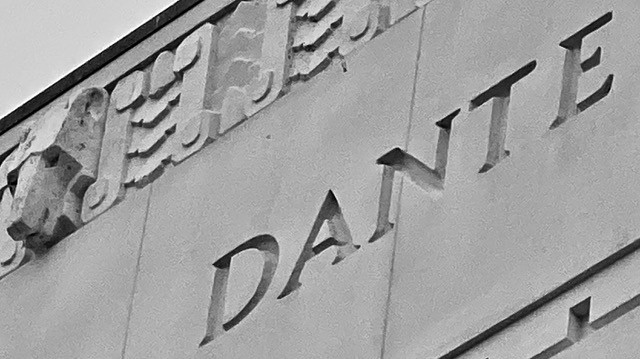
“Discarded Image” photo by Bruce Donehower
“The Tradition” and Individual Talent
We briefly made use of the biographies of Mary Wollstonecraft Godwin, Mary Godwin Shelley William Blake, Thomas Taylor, and Percy Shelley to explore in the manner of karmic research the literary significance of these writers when we read their works from the perspective of a spiritual science.
To assist us in this task, we turned once more to critics such as Kathleen Raine and C.S Lewis. In previous meetings, prior to our work with Novalis, we discussed Kathleen Raine’s two volume masterpiece “Blake and the Tradition.” Last night we supplemented this discussion of “the Tradition” with a reference to C.S. Lewis’ book “The Discarded Image.” In particular, we looked at a passage in which Lewis discusses “intellectual light.” This term was chosen for discussion because it highlights what we might call “the problem of fallen language” in the age of scientistic mathematical-materialism. I don’t know about you, but from where I’m sitting these days the word “intellectual” is hardly a term of endearment in the US of A. Thus, when Shelley titles a poem “Hymn to Intellectual Beauty” we are stopped dead in our tracks because we lack an historical understanding of the word intellectual in the literate humanistic sense that Shelley uses the term — to say nothing of the word “beauty.” These days, for the most part, all reference to “Geist” (German) or “Spirit” (English) have been scoured from the word. And this is entirely in keeping with Steiner’s poetic image of “the fall of spirits of darkness” and the consequent changes in psyche and society. Language is of course not exempted from this “fall,” as Barfield also has explored.
“So, when Dante passes that last frontier, he is told, ‘We have got outside the largest corporeal thing (del maggior corpo) into that Heaven which is pure light, intellectual light, full of love’ (Paradiso, XXX, 38). In other words, as we shall see more clearly later on, at this frontier the whole spatial way of thinking breaks down. There can be, in the ordinary spatial sense, no ‘end’ to a three-dimensional space. The end of space is the end of spatiality. The light beyond the material universe is intellectual light.”
— C.S. Lewis, from “The Discarded Image”
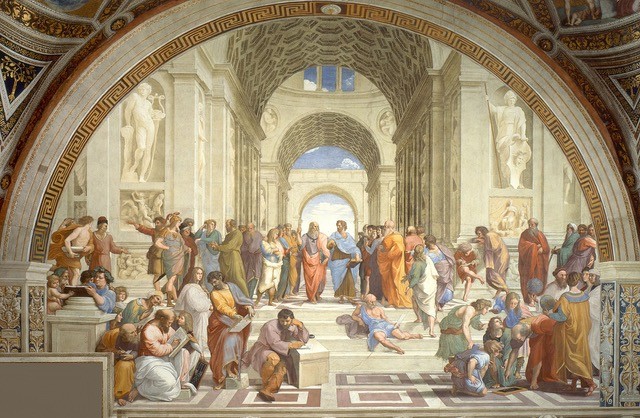
“The School of Athens” by Raphael
The Genius of Language
We frequently start our Section meetings with a verse that Rudolf Steiner gave to the teacher of Greek and Latin at the inauguration of the first Waldorf School in Stuttgart, Germany in 1922. This verse begins “To one who understands the sense of speech.” Click this sentence to read the entire verse and a PDF of the book of lectures in which the verse is found.
In the past, we have not had sufficient context or opportunity in our Section meetings to explore this topic of “the genius of language.” True, we have attempted some discussion — most notably in our meetings that presented Owen Barfield. But in order to progress with our examination of what I am calling “The Question” — namely “What is the Significance of the Literary Arts and Humanities and How Does this Section Contribute Uniquely to a Spiritual Science?” — we will need to extend our research in this direction, most likely. In our meeting last night, we took one more tiny step toward this goal of inquiry. As time permits, I hope we can read Shelley’s poetry within the context of this inquiry. And, as time permits, we should also take a look at “The School of Athens” and the figure of Hypatia — the only person in this painted scene by Raphael who looks directly at us — and also the only woman represented in this painting. Oder?
“Linguistics, in its various modes, is nevertheless one of the most important disciplines that human beings have developed throughout the course of evolution because—as I will suggest in the concluding section of this afterword—it is the prototypical consciousness soul discipline for our time which, if it is properly cultivated, will lead us to the ability to “think about thinking,” which is a spiritual activity of consciousness in freedom.”
— Adam Makkai, from the Afterword to “The Genius of Language,” Lectures by Rudolf Steiner
The Mystery of the Two Marys
But we might just as well stick to themes of modernity and revolution. No better figures recommend themselves for such a radical exploration of the “sprit of the time” than Mary Wollstonecraft and her daughter Mary Godwin Shelley. Thankfully, at our Section meetings in past years we spent considerable time on Mary Shelley’s masterpiece Frankenstein — a book that speaks presciently to our postmodern anxieties of “trans-humanism.” But Covid interrupted our acquaintance with Mary Wollstonecraft.
To re-enliven that acquaintance, I introduced the meeting participants to a recent lively biography of the two Marys: Romantic Outlaws by Charlotte Gordon I highly recommend that you read or listen to this enjoyable and helpful book. As I mentioned several times in previous meeting summaries, we intended to proceed from William Blake to Mary Wollstonecraft in our exploration of the Michaelic challenge of late eighteenth century romanticism, but Covid arrived and Novalis appeared from out of the blue (no pun intended) to divert our attention to Germany. But now we’re back to the English language! The details of the “Mary” biographies will assist with our questioning of British romanticism in respect to Rudolf Steiner’s spiritual scientific reading of the late eighteenth century and nineteenth century and Rudolf Steiner’s karmic lectures on the School of Michael — that is to say, if we can proceed down the road again. These days, you never know.
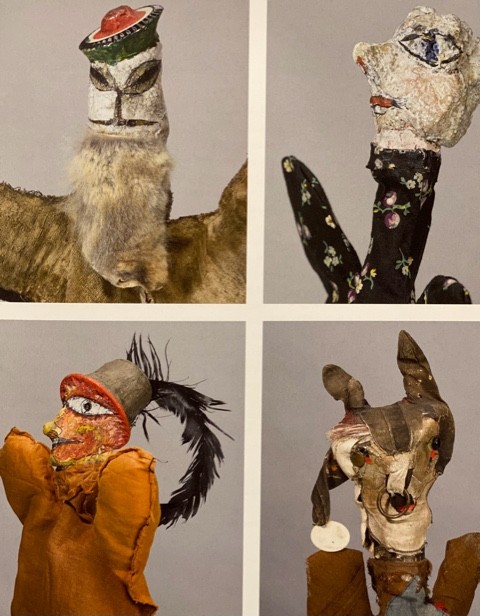
“Puppets” by Paul Klee
Guess Who? Boo! Tricks & Treats!
Halloween is approaching. But we prefer to celebrate the day as John Keats’ birthday. (Goethe thought that romanticism was a bit like Halloween, nicht wahr? But he should talk — with all that Brocken business in Faust!) October 31 is also the eve of the launch of the website TheLiteraryArts.com — which, apropos, celebrates its one year anniversary of “Hello World!” at this time of remembrance of the dead.
Marion is heading up a project to create a movie or theater experience with puppets inspired by Paul Klee. This is an outgrowth of the summer Fairy Tale group. We discussed the initiative last night. (Nicholas, did I really hear you say “mystery drama”?!) Contact Marion if you want more information. She is coordinating the cast and all matters related to staging.
On Saturday, October 30, the Section will host Canadian poet Philip Thatcher at 7 pm Pacific. Philip will read from his new book of poems, and he will discuss the poet’s process. For a review by Fred Dennehy of Philip’s recent book Fine Matter, click this sentence.
“Thatcher’s verse can curve like a river, with rhythmic word recurrences unfolding through narratives of sentient surprise. He is also an accomplished novelist (The Raven Trilogy), and he speaks to us in pitch perfect tones, while refusing to allow his lines to say anything not truly heard.”
— from Fred Dennehy’s review of Fine Matter
Also on board for special presentations this fall are Fred Dennehy and Clifford Venho. Fred was with us earlier to share some thoughts about Owen Barfield. Click this sentence to watch a 30-minute video of Fred’s fascinating lecture. Poet, eurythmist, translator, and essayist Clifford was with us earlier to share thoughts about Christian Morgenstern. As many of us know, Christian Morgenstern was a special friend of Rudolf Steiner and a poet whom Steiner repeatedly recommended to our attention. Click this sentence to watch a 30-minute video of Clifford’s inspiring talk.
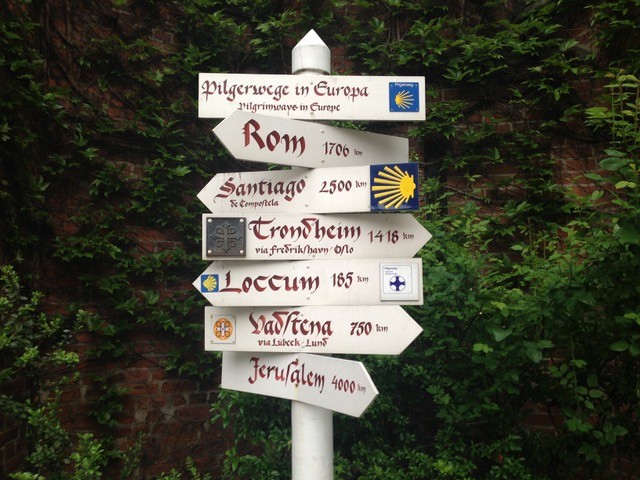
“New Directions for the Literary Arts?” photo by Bruce Donehower
Poets and Landscapes
Also in the season of All Souls, if spirit and body co-operate, I plan to circumambulate Mt. Tamalpais with my son in early November as a ritual family commemoration of a famous literary event that American poets Gary Snyder, Jack Kerouac, Allen Ginsberg, and Philip Whalen inaugurated. I’ll speak more about this adventure in later meeting summaries, but in the meantime, if you want to learn the background and have some fun in the spirit of Beat California Buddhist enlightenment, read Jack Kerouac’s The Dharma Bums. Those who have worked in the Section with me for a long time (we know your names), will remember that in the spry first decade of the 21st century we did this circumambulation as a group activity. Ah, “time, cash, strength, and patience,” as Hermann Melville famously and aptly complained.
We scheduled a poetry night for December 18. This event supplements the event calendar that I published two weeks ago. Click this sentence to read the calendar of events for autumn 2021.The calendar has been supplemented to include our December 18 Advent Salon Festival Celebration. Thiis meeting might run longer than an hour. Stay tuned for details! Poets, start writing your poems! And “poets” includes everyone, as Novalis has told us — or at least everyone in the “know” (wink wink nod nod).
And don’t forget to check our news Books, Essays, and Publications on the Books & Essays page of the site. May the Reader flourish!
________
“They say that thou wert lovely from thy birth,
Of glorious parents, thou aspiring Child.
I wonder not—for One then left this earth
Whose life was like a setting planet mild,
Which clothed thee in the radiance undefiled
Of its departing glory; still her fame
Shines on thee, through the tempests dark and wild
Which shake these latter days; and thou canst claim
The shelter, from thy Sire, of an immortal name.”
— Poem by Shelley to Mary Godwin in which Shelley praises Mary’s mother, Mary Wollstonecraft
“Materialism had, of course, reached its peak in the 1840s, but in those days its impulses were more instinctive in humans, for the crowd of ahrimanic spirits still sent their impulses from the spiritual world into human instincts. From the autumn of 1879 onwards, these ahrimanic impulses — powers of perception and of will — became the personal property of human beings.”
— Rudolf Steiner, from lecture nine in “The Fall of the Spirits of Darkness”

